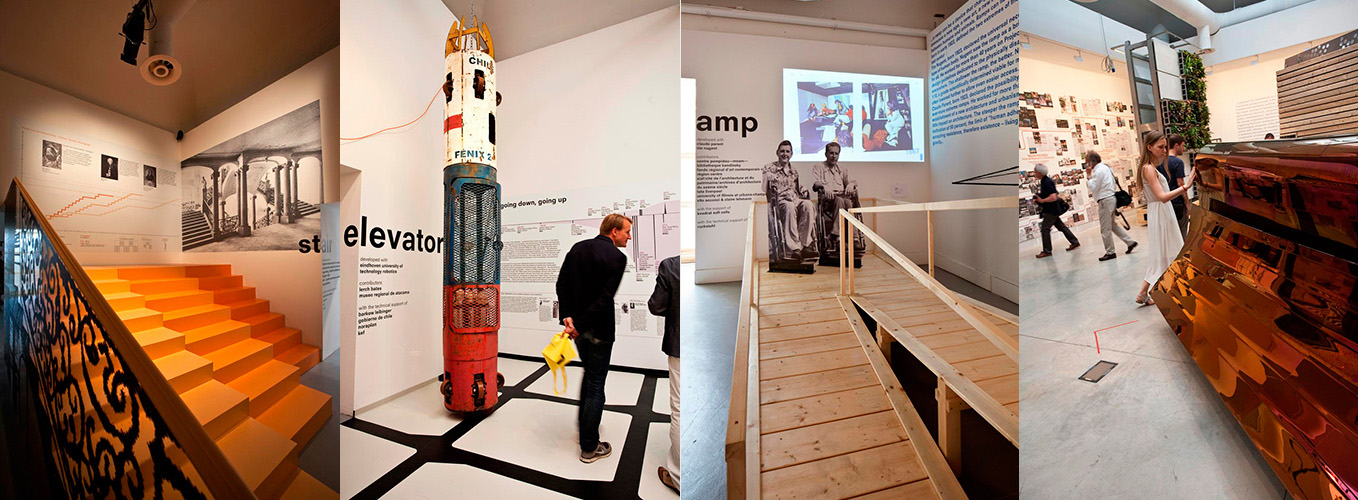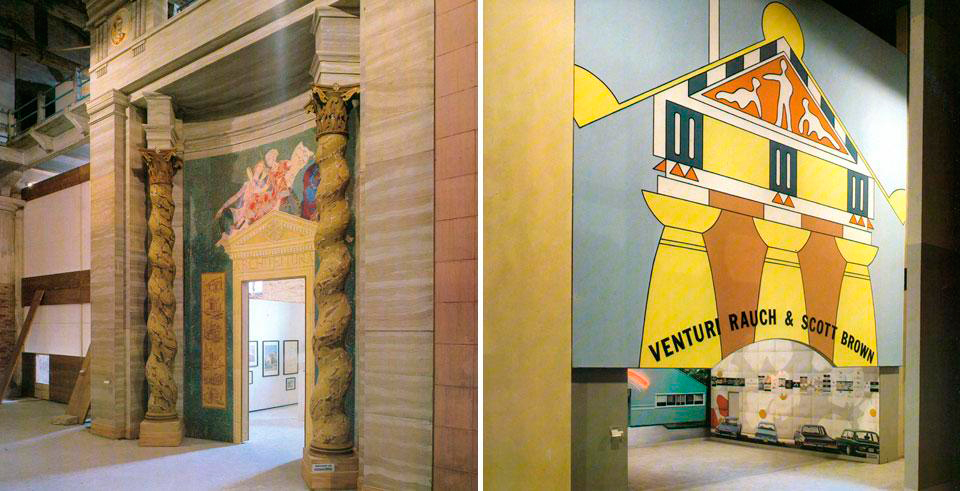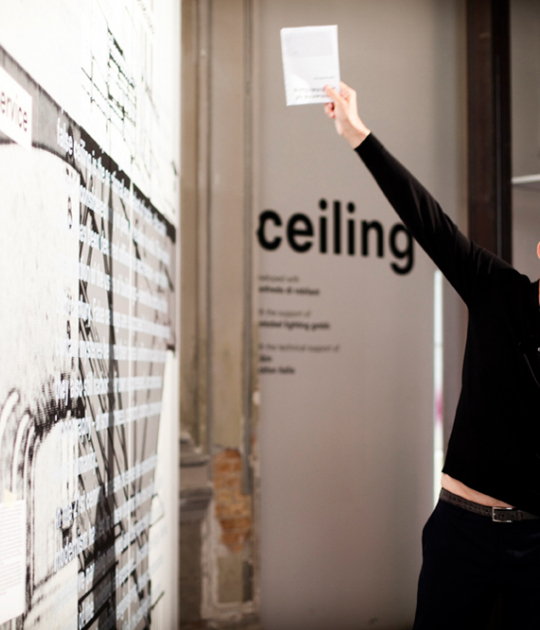It was in 2010, in the Biennale curated by Kazuyo Sejima, when Rem Koolhaas referred to the 1980 Biennale during his exhibition "Cronocaos", which established a deep debate about conservation vs. demolition of Modern Architecture.
“Let's start from the beginning”,(01) said Hans Ulrich Obrist to Rem Koolhaas in his interview, trying to ascertain what the start was, the first epiphany of his interest in conservation and his way to "Cronocaos". The answer was routed to the 1980 Biennale curated by Paolo Portoghesi, called "The presence of the past", as mentioned in consideration then, to postmodern movement. As for Rem Koolhaas "The Presence of the Past" was the last time a Biennale drew attention to the conservation issue. It addressed matters related to concerns that, according to Charles Jencks, approach the "lost language of architecture"(02) and were closely aligned with postmodern movement with a strong presence of historicism. This Biennale consisted of three exhibitions, one of them devoted to the younger generation of the time, among which was Rem Koolhaas.

1. INTRODUCTION. 2. CEILING. 3. DOOR. 4. FLOOR. Elements of Architecture. Central Pavilion, Venice Biennale 2014. Photography © Francesco Galli. Courtesy of la Biennale di Venezia.
 5. STAIRS. 6. ELEVATOR. 7. RAMP. 8.FAÇADE. Elements of Architecture. Central Pavilion, Venice Biennale 2014. Photography © Francesco Galli. Courtesy of la Biennale di Venezia.
5. STAIRS. 6. ELEVATOR. 7. RAMP. 8.FAÇADE. Elements of Architecture. Central Pavilion, Venice Biennale 2014. Photography © Francesco Galli. Courtesy of la Biennale di Venezia.
"The first Venice Architecture Biennale in 1980 provided a vital springboard for Post-Modernism, providing it with an international stage. (...) its facades by eminent architects of the time, is now a seminal image of 20th-century architecture. (...) the prominence given to the past in the show's theme was a point of contention among the exhibition's organisers."(03)
The exhibition did not escape controversy; there were those who considered it a "pastiche" as Bruno Zevi, who in an open discussion with Paolo Portoghesi stated that the exhibition suggested a difficult leap toward buildings restoration. Or as Vittorio Gregotti who saw it as "an orgy of fake columns".(04) There were also some important "absences". Kenneth Frampton, part of the organizing committee, resigned before the opening ceremony, because he believed in a revisionist modernism, in contrast to the central speech, which more than postmodern was rather anti-modern. Another clear absence was Peter Eisenman, who rejected the invitation following Manfredo Tafuri advice.(05)
The figure of Peter Eisenman in the Biennale 2014 has been more noticeable. The architect sparked controversy by declaring that "Rem Koolhaas presents the Biennale as la fine [the end]: 'The end of my career, the end of my hegemony, the end of my mythology, the end of everything, the end of architecture." "Look, 50 years ago, we knew that Modernism was dead. Le Corbusier, Mies van der Rohe, Frank Lloyd Wright: all dead. We didn't know what the future was but we knew all this was dead.”(06)
These statements may relate to the supposed "death of modern architecture" that Charles Jencks announced in the 1970s after the demolition of Pruitt-Igoe. It was a proclamation that was full of myths which brought deeper and more complex connotations along in the early 1980s, and have been taken up in recent years in campaigns for the assertion of Modernity. In fact, "Absorbing Modernity 1914-2014" one of the three parts of "Fundamentals" commemorates 100 years of Modern Architecture, inviting people into a journey to the origins of globalization.
Given the controversy by Peter Eisenman and his skepticism about the intentions of Rem Koolhaas's return to basics, Charles Jencks recently mentioned it in The Architectural Review: “was it a kind of fundamental pragmatism? (…) I found an unlikely parallel with Eisenman’s own work, especially in its conscious destabilising of the professional paradigm.” (07)
For one to suggest the end of Rem Koolhaas’s hegemony, Peter Eisenman has used Koolhaas own critical stance: "The star architect is a figure that does not exist, it is a commonplace to refer to those who earn lots of money and make all the projects they want. An invention of lazy journalists".(08) He had already anticipated it in "Cronocaos" where one of the panels showed that the last time an architect appeared on the cover of Time magazine was in 1979 showing Philip Johnson (to whom 1980 Biennale devoted a special exhibition).
“The rise of the market economy has meant the end of the architect as a credible public figure. (…) Starchitects accepted a Faustian bargain where they became more prominent, but their role less significant.” (09)
This is one of the main differences between 1980 and 2014 Biennales: while Paolo Portoghesi aimed to bring back the competition between architects, as in the sixteenth century and the Baroque period, Rem Koolhaas chose to focus on architecture, not on architects.

1st International Architecture Exhibition, "The Presence of the Past". Drawing by Arata Isokazi; Ddrawing by Frank O. Gehry; The Arsenale's Corderie before renovation; Drawing by Stanley Tigerman. Source.- Domus 610, 1980, p. 9 -15.

1st International Architecture Exhibition, "The Presence of the Past." Drawing by Robert A.M. Stern; Drawing by Michael Graves; Drawing by Franco Purini and Laura Thermes; Drawing by Massimo Scolari. Source.- Domus 610, 1980, p. 9 -15.
The 1980 Biennial depicted a more distant but better valued classical past, compared to the past being commemorated nowadays. Thus, in 2014 it was important to "sever all connections with contemporary architecture which, in spite of many impressive manifestations, is not in good health and to focus instead on the progression of global architecture over the last 100 years”(10) that demonstrates that national identity has been sacrificed to modernity. “Some might view this as a project of reclamation, not unlike Frampton’s regionalism” (11) , points an interview with Rem Koolhaas for The Architectural Review about "Fundamentals", in which Koolhaas sets the differences with Kenneth Frampton’s theory (who resigned to the 1980 Biennale):
“Kenneth Frampton (…) looked at regionalism as an antidote to cosmopolitan development. In so doing he perverted the cause of regionalism, because suddenly regionalism was mobilised as a private cause that it couldn’t sustain. However, the question of national identity is an open one.” Even very internationalist countries have chosen quasi-vernacular architecture, however, according to Koolhaas modern architecture as well as traditionalism they are part of an advertising strategy philosophy: “the vast majority of so-called modern architecture now is really a kind of gimmicky Modernism, and this creates space for traditionalism to be gimmicky too. (…) I see this less from an architectural perspective than from a social or anthropological one.” (12)
These hundred years nuanced, according to each country, being under war pressure very different political regimes, multiple growing conditions, architectural movements, individual talents, technological development, not only profoundly influenced in the architecture of our time, but are still very latent:
"I think architecture is written about as if it is a dead serious discipline, but I think there is life in architecture" (13) says Koolhaas. "Modernity is a painful process, some countries have been forced to modernize rapidly." (14) Rem Koolhaas has broken the paradigm of previous Biennales dedicating the current one to the celebration of the contemporary focusing on history, in order to “reconstruct how architecture finds itself in its current situation, and speculate on its future.” (15)
"The presence of the past", "Cronocaos", "Fundamentals"; to each biennale its dispute, or perhaps the same dispute, woven of encounters and clashes between the "archistars" that even though they don’t want to, have become protagonists of the stories that have shaped (or deformed) our views on the architecture of our time” .

1st International Architecture Exhibition, The Presence of the Past. Left, façade by Thomas Gordon Smith; right, façade by Venturi, Rauch & Scott-Brown. Source.- Domus 610, 1980, p. 12 -13.
NOTES.-
1. KOOLHAAS, Rem, entrevista de Hans ULRICH OBRIST. «Interview with Rem Koolhaas.» Architecture Biennale - OMA Office for Metropolitan Architecture (NOW Interviews). La Biennale di Venezia Channel. Arsenale. 25 August 2010.
2. JENCKS, Charles. «The Presence of the Past.» DOMUS, nº 610 (april 1980). Pp. 9-15.
3. SZACKA, Léa-Catherine. «Historicism versus communication. The basic debate of the 1980 Biennale.» Architectural Design, nº 213 (September 2011): P. 98.
4. Ibidem (3): P. 105.
5. Op. cit. (3): P. 105.
6. CIUFFI, Valentina. «Peter Eisenman challenges to Rem Koolhaas.» METALOCUS. 9 June 2014.
7. JENCKS, Charles. «The Carnival of Thought: Charles Jencks on the Venice Biennale.» The Architectural Review. 25 June 2014.
8. FERNÁNDEZ, Milena. «Rem Koolhaas contra las estrellas.» El País, January 2014.
9. KOOLHAAS, Rem. «Cronocaos.» Venice Biennale. Exhibition . Venice, 2010.
10. BARBA, José Juan. «Rem Koolhaas: "reconstruct its current situation, and speculate of the future".» METALOCUS. 11 March 2014.
11. MACKENZIE, Andrew. «Batik, Biennale and the death of the skycraper. Interview with Rem Koolhaas.» The Architectural Review. 24 February 2014.
12. Ibidem. (11).
13. Op. cit. (10).
14. KOOLHAAS, Rem. En SALAS, Roger. «La Bienal de Venecia se rebela contra los arquitectos estrella.» El País, 5 June 2014.
15. Op. cit. (10).






























